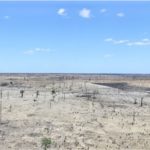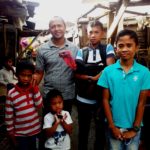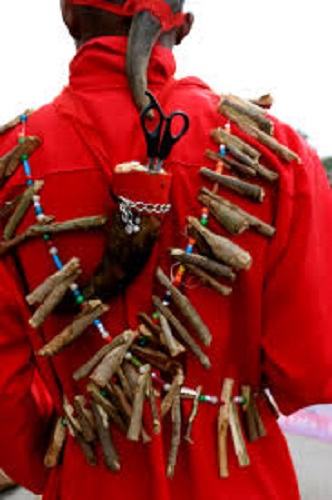Famadihana burial rites from Madagascar
Long live the dead!
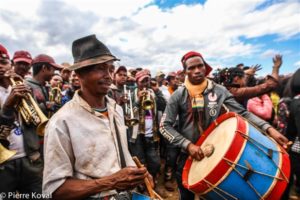
From July to November, the "famadihana" enlivens the highlands, a joyous reunion of the living and the ancestors.
The custom of turning the dead has resisted the missionary zeal of the past and the purism of health.
The Malagasy observe two burial rites
The first brings the individual from the world of the living to the world of the dead; the second brings the deceased to the world of the ancestors and installs his protective power.
There are regional variations of this ceremony, but the best known are those practiced by the Merina under the name famadihana and the Sihanaka under the name jamà.
They consist of returning a person who died far away to the family grave or exhuming the remains of a deceased person, as well as those of the great ancestor and sometimes other ancestors, to offer them new shrouds.
 Customs during the Famadihana
Customs during the Famadihana
Second burial, hence "Famadihana", the ceremony takes place during the southern winter between June and September.
It is customary for an ancestor to appear in a dream to one of his descendants to complain about the cold: the family then consults an astrological soothsayer (mpanandro) who sets the correct date for the ritual
Duty of the descendants
The zana-drazana, descendants of the people exhumed during the famadihana, are the central actors of the ceremony.
They are the instigators, hoping to reap the rewards. The color of their costume, prescribed by the astrological diviner, distinguishes them from the other participants.
Feast of the dead, feast of the living
None Famadihana Without music.
The celebration takes place amid the noise of brass instruments, flutes, clarinets and drums of a brass band.
No festival of the dead without decibels, which are an integral part of the rites.
The expression "a noise to wake a dead" resembles the reality in Madagascar. Because, the dead hear and dance with the living.
An ensemble of clarinets and trumpets accompanies the tireless dancers, some of whom d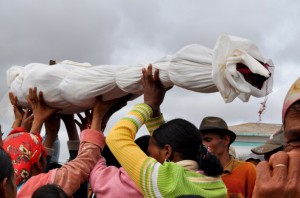
All generations of the same family are gathered to sing and have fun.
The atmosphere is reminiscent of a wedding or a big birthday party, but the festivities take place around a grave.
In fact, the day before the ceremony celebrations, they are called to return to their final resting place.
The latter must pay homage to the ancestors, but also please the living. To celebrate their communion with their ancestors, the Zana-drazana (the children of the ancestors) seven times around the grave, dancing, carrying the remains wrapped in their new shroud on their heads or shoulders.
If some can not help but shed tears, they do so discreetly, because the Famadihana must be a moment of joy.
Regional differences
Exhumation: ati-damba
Among the Sakalava from the Menabe, this ritual, called ranga an-dolo, takes place one year after the funeral.
The Betsimisaraka from the Northeast perform this rite two or three years after death and call it famongarana.
The Betsimisaraka of the center-east, on the other hand, let their deceased rest in peace, but they erect "male" (vatolahy) or "female" (vatovavy) stones, which they periodically wrap in a shroud of ordinary cloth.

This ritual has different regional forms, several of which have deep symbolic similarities: The famongarana predominates among the northern Betsimisaraka, the ranga an-dolo is a Menabe sakalava ceremony, while the jamé is perpetuated by the Sihanaka.
Despite the differences in forms associated with local history and identity structures, there is a common meaning in the rituals of all regions: in each case, it is a basic ceremony in which the deified dead are honored.
Ancestors who were sanctified in this way are asked to bless their descendants and exercise protective power over them.
Ceremony of reburial of the corpse
The fanfare band, perched above the tomb, plays the songs in a steady rhythm as the bodies follow one another.

The bodies of the deceased are wrapped in shrouds covered with willow mats.
Their offspring then carry them on their shoulders, dance and drink alcohol.
Sometimes they pour a generous shot of alcohol over the bodies of their ancestors.
The scene may look morbid from the outside. But there are no tears or sad faces here.
There is an atmosphere of enthusiasm. "What's the atmosphere like?" I am often asked if I am also enjoying myself.
A costly rite
Originally, exhumation was practiced when a person died far from his region of origin. A feast was held when the body of the deceased was returned to his family.
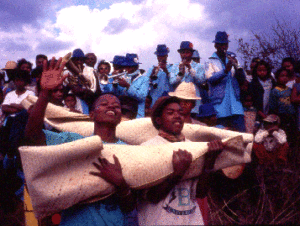
The economic situation often does not allow the majority of the Malagasy population to buy shrouds during the 'famadihana' period (...).
A "famadihana" is organized at intervals of 3, 5 or 7 years, but due to lack of funds some are unable to keep this tradition.
The ceremony is sometimes associated with colossal costs, the celebration lasts 2 days, during which many guests must be fed.
The "vary be menaka", a rice soaked in oil accompanied by zebu meat, is one of the menus that delight the whole family.
In addition to the cost of the meal, there is the cost of the band and the cost of the "lambamena", a silk cloth that covers the body of the deceased to protect it from the cold.
However, due to declining purchasing power, many Malagasy households no longer have the luxury of buying traditional "lambamena," opting instead for synthetic fabrics.
Malagasy families save for a long time and sometimes incur debts to honor their dead with a "famadihana".
 Corpse meal
Corpse meal
The Famadihana gives rise to a different be menaka.
This feast consists of a dish of rice and zebu or pork as fat as possible, and accompanied with Toaka Gasy, a local rum made from sugar cane.
Protection and fertility
The mats that have come into contact with the remains become sacred and are said to be able to make a woman fertile. Therefore, at the end of the ceremony, all those who want to have a child confiscate a piece.
A student who wants to pass his exams or a couple who wants to have children can use a "handover session to the dead" to ask for the help of the deceased.
Endogenous aspects of a ceremony
The stories collected in the villages give the Famadihana a completely different dimension, both in terms of its sacred meaning and as a vector of social cohesion.
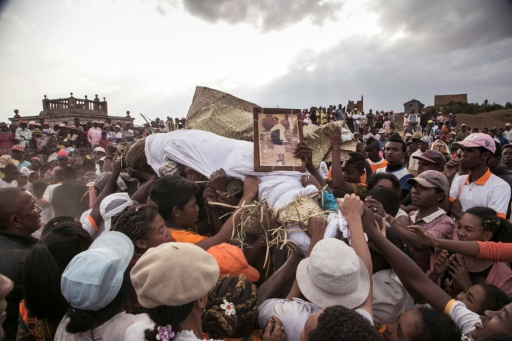
Death is an integral part of the life process.
The ancestors are present in the symbolic imagination of the living. This happens on such a playful level: it is not uncommon to meet children who playfully represent the famadihana in symbolic transpositions, carrying locusts wrapped in banana leaves as if they were the body of an ancestor.
Orality and proximity of the ancestors
Moreover, riddles from the oral tradition refer to the essential sacred act of offering the new shroud: the lambamena, the shroud, is sacred, but it is also the object of the games of the mind.
This puzzle shows the relationship of complexity, which is maintained with the ancestors, you can even make jokes about them:
We open the coffin, take off the shroud and eat the corpse, what is this?
… … ?
It is a peanut.
Spirituality and astrology
Regarding the periodicity and the determination of the organization of a famadihana, we have heard a recurring story that the deceased appears in a dream to one of his descendants to tell him that he is cold.

The Famadihana is the community of the living asking for the blessing of the dead, and a tribute to Tanindrazana, the land of the ancestors, the Malagasy homeland.
The relationship between the audience gathered around the tomb and the astrologer who presides over the ceremonies is always mixed with courtesy and constant references to the values shared by the group.
The Kabary (Speech of the astrologer, the council of elders and the official in charge) is an essential part of the ceremony.
The approach from within allows us to promote a true visual anthropology of the ritual, highlighting the expression of the participation of the group and the different levels and layers of this ancestral homage: Dreams and astrology, economy, psychological relationships, lineage hierarchies of performance.

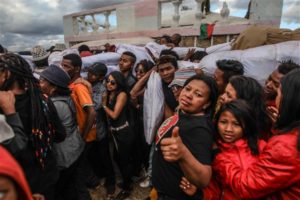
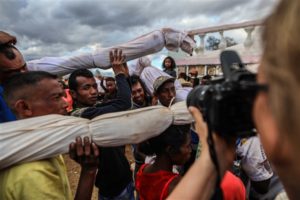
 Corpse meal
Corpse meal

